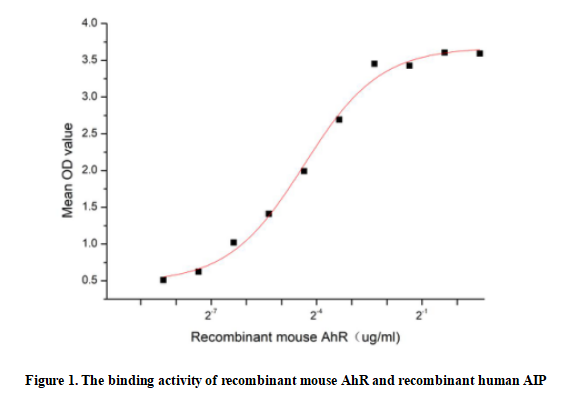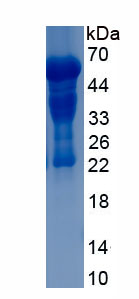Active Aryl Hydrocarbon Receptor (AhR) 

BHLHE76; Class E basic helix-loop-helix protein 76
- UOM
- FOB US$ 364.00 US$ 910.00 US$ 1,820.00 US$ 5,460.00 US$ 13,650.00
- Quantity
Overview
Properties
- Product No.APB354Mu01
- Organism SpeciesMus musculus (Mouse) Same name, Different species.
- ApplicationsCell culture; Activity Assays.
Research use only - DownloadInstruction Manual
- CategorySignal transductionTumor immunityInfection immunityDermatology
- Buffer FormulationPBS, pH7.4, containing 0.01% SKL, 5% Trehalose.
- Traits Freeze-dried powder, Purity > 80%
- Isoelectric Point7.8
Sign into your account
Share a new citation as an author
Upload your experimental result
Review

Contact us
Please fill in the blank.
Activity test

Aryl Hydrocarbon Receptor (AhR), a protein of substantial molecular mass, typically ranging from 110 to 150 kilodaltons, is a member of the esteemed Basic Helix-loop-helix PAS (Per-Arnt-Sim) family of transcription factors. Ubiquitously expressed in vertebrate cells, AhR's activity is meticulously modulated by a variety of ligands. This receptor is pivotal in orchestrating gene transcription, thereby wielding considerable influence over a multitude of biological processes.Aryl Hydrocarbon Receptor Interacting Protein (AIP)can combine with AHR to regulate the endocrine system.Thus a functional ELISA assay was conducted to detect the interaction of recombinant recombinant mouse AhR and recombinant human AIP. Briefly, AhR was diluted serially in PBS with 0.01% BSA (pH 7.4). Duplicate samples of 100 μl were then transferred to AIP-coated microtiter wells and incubated for 1h at 37℃. Wells were washed with PBST and incubated for 1h with anti-AhR pAb, then aspirated and washed 3 times. After incubation with HRP labelled secondary antibody for 1h at 37℃, wells were aspirated and washed 5 times. With the addition of substrate solution, wells were incubated 15-25 minutes at 37℃. Finally, add 50 µL stop solution to the wells and read at 450/630nm immediately. The binding activity of recombinant recombinant mouse AhR and recombinant human AIP was shown in Figure 1, the EC50 for this effect is 0.49ug/mL.
Usage
Reconstitute in 10mM PBS (pH7.4) to a concentration of 0.1-1.0 mg/mL. Do not vortex.
Storage
Avoid repeated freeze/thaw cycles. Store at 2-8°C for one month. Aliquot and store at -80°C for 12 months.
Stability
The thermal stability is described by the loss rate. The loss rate was determined by accelerated thermal degradation test, that is, incubate the protein at 37°C for 48h, and no obvious degradation and precipitation were observed. The loss rate is less than 5% within the expiration date under appropriate storage condition.
Increment services
-
 BCA Protein Quantification Kit
BCA Protein Quantification Kit
-
 Molecular Mass Marker for Protein
Molecular Mass Marker for Protein
-
 Monoclonal Antibody Customized Service
Monoclonal Antibody Customized Service
-
 Polyclonal Antibody Customized Service
Polyclonal Antibody Customized Service
-
 Protein Activity Test Experiment Service
Protein Activity Test Experiment Service
-
 Electrophoretic Mobility Shift Assay (EMSA) Experiment Service
Electrophoretic Mobility Shift Assay (EMSA) Experiment Service
-
 Buffer
Buffer
-
 Lentivirus Packaging Experiment Service
Lentivirus Packaging Experiment Service
-
 Adenovirus Packaging Experiment Service
Adenovirus Packaging Experiment Service
-
 Real Time PCR Experimental Service
Real Time PCR Experimental Service
-
 Spike RBD Protein (S-RBD)
Spike RBD Protein (S-RBD)
-
 Protein G
Protein G
-
 Protein A
Protein A
Citations
- Isomer-nonspecific action of dichlorodiphenyltrichloroethane on aryl hydrocarbon receptor and G-protein-coupled receptor 30 intracellular signaling in apoptotic neuronal cellsPubmed:24859647
- Depressive-like effect of prenatal exposure to DDT involves global DNA hypomethylation and impairment of GPER1/ESR1 protein levels but not ESR2 and AHR/ARNT signalingpubmed:28263910
- Investigation of Aryl Hydrocarbon Receptor, Zinc, and Vitamin B12 Levels in Chronic Gastritis with Helicobacter pylori Infection33723799
- Association of aryl hydrocarbon receptor (AhR) serum level and gene rs10247158 polymorphism with anthropometric, biochemical parameters and food consumption ¡34091989







